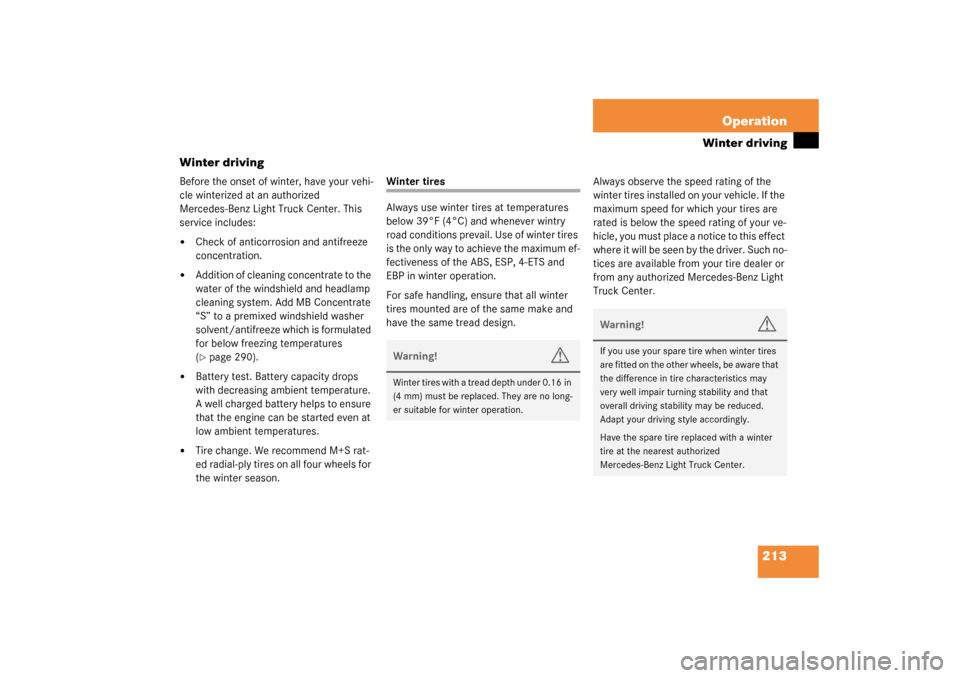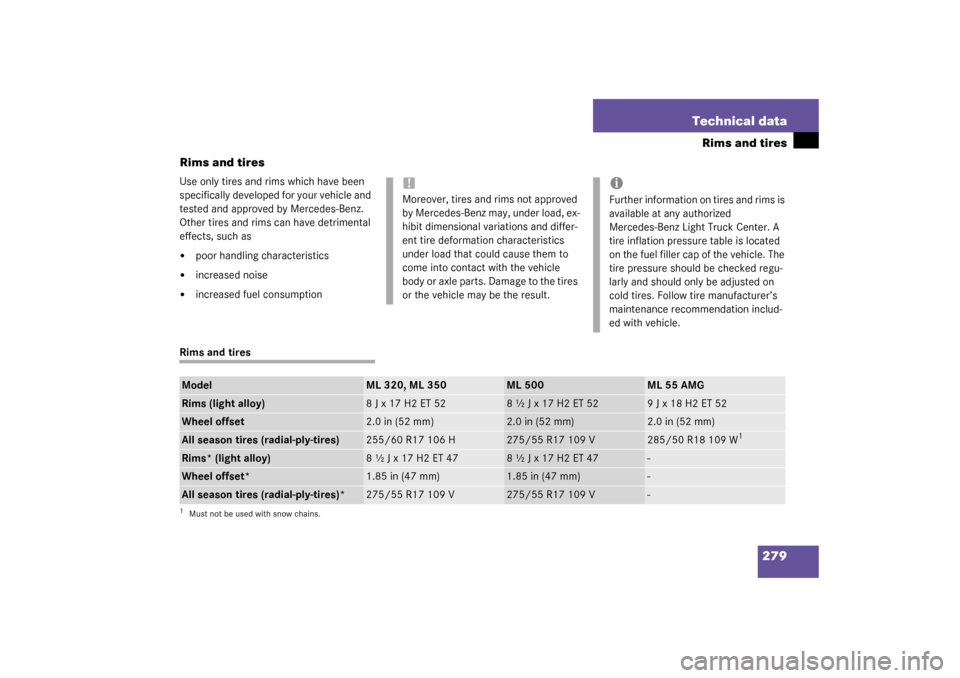Page 210 of 321
210 OperationTires and wheels
Life of tire
The service life of a tire is dependent upon
varying factors including but not limited to:�
Driving style
�
Tire pressure
�
Distance driven
Direction of rotation
Unidirectional tires offer added advantag-
es, such as better hydroplaning perfor-
mance. To benefit, however, you must
ensure that the tires rotate in the direction
specified.
An arrow on the sidewall indicates the in-
tended direction of rotation of the tire.
!When the wheels are heavily soiled,
e.g. after driving through mud, clean
the inside of the wheels with a jet of
water.
Warning!
G
Tires and spare tire should be replaced after
six years, regardless of the remaining tread.!Keep unmounted tires in a cool, dry
place with as little exposure to light as
possible. Protect tires from contact
with oil, grease and gasoline.
Page 211 of 321

211 Operation
Tires and wheels
Checking tire inflation pressure
Correct the tire pressure only when tires
are cold.
Regularly check your tire pressure at inter-
vals of no more than 14 days.
If the tires are warm, you should only cor-
rect the tire pressure if it is too low for cur-
rent operating conditions.
A table on the fuel filler flap lists the spec-
ified tire inflation pressures for warm and
cold tires as well as for various operating
conditions.Tire pressure changes by approximately
1.5 psi (0.1 bar) per 18°F (10°C) of air
temperature change. Keep this in mind
when checking tire pressure where the
temperature is different from the outside
temperature.
Tire temperature and tire pressure are also
increased while driving, depending on the
driving speed and the tire load.Check the spare tire periodically for condi-
tion and inflation. Spare tire will age and
b e c o m e w o r n o v e r t i m e e v e n i f n e v e r u s e d ,
and thus should be inspected and replaced
when necessary.Warning!
G
If the tire pressure repeatedly drops:�
Check the tires for punctures from for-
eign objects
�
Check to see whether air is leaking from
the valves or from around the rim
iThe pressures listed for light loads are
minimum values offering high driving
comfort.
Increased inflation pressures listed for
heavier loads may also be used for light
loads. These higher pressures produce
favorable handling characteristics. The
ride of the vehicle, however, will be
somewhat harder. Never exceed the
max. values or inflate tires below the
min. values listed in the fuel filler flap.
Warning!
G
Follow recommended inflation pressures.
Do not overinflate tires. Overinflated tires
can result in sudden deflation (blowout) be-
cause they are more likely to become punc-
tured or damaged by road debris, potholes
etc.
Do not underinflate tires. Underinflated tires
wear unevenly, adversely affect handling
and fuel economy, and are more likely to fail
from being overheated.
Do not overload the tires by exceeding the
specified vehicle capacity weight (as indicat-
ed by the label on the pillar in the driver’s
door opening). Overloading the tires can
overheat them, possibly causing a blowout.
Page 212 of 321
212 OperationTires and wheelsRotating wheels
The wheels can be rotated every 3000 to
6000 miles (5 000 to 10 000 km) or sooner
if necessary, according to the degree of
tire wear. The same direction of tire rota-
tion must be retained.
Rotate the wheels before the characteris-
tic tire wear pattern becomes visible
(shoulder wear on front wheels and tread
center wear on rear wheels).
Thoroughly clean the inner side of the
wheels after each rotation. Check and en-
sure proper tire inflation pressure.Information on changing a wheel can be
found in the “Practical hints” section
(
�page 255).
Warning!
G
Rotate front and rear wheels only if they are
of the same size,
Warning!
G
Have the tightening torque checked after
changing a wheel. Wheels could become
loose if not tightened with a torque of
110 ft.lb. (150 Nm).
Use only genuine Mercedes-Benz wheel
bolts specified for your vehicle's rims.
Page 213 of 321

213 Operation
Winter driving
Winter driving
Before the onset of winter, have your vehi-
cle winterized at an authorized
Mercedes-Benz Light Truck Center. This
service includes:�
Check of anticorrosion and antifreeze
concentration.
�
Addition of cleaning concentrate to the
water of the windshield and headlamp
cleaning system. Add MB Concentrate
“S” to a premixed windshield washer
solvent/antifreeze which is formulated
for below freezing temperatures
(�page 290).
�
Battery test. Battery capacity drops
with decreasing ambient temperature.
A well charged battery helps to ensure
that the engine can be started even at
low ambient temperatures.
�
Tire change. We recommend M+S rat-
ed radial-ply tires on all four wheels for
the winter season.
Winter tires
Always use winter tires at temperatures
below 39°F (4°C) and whenever wintry
road conditions prevail. Use of winter tires
is the only way to achieve the maximum ef-
fectiveness of the ABS, ESP, 4-ETS and
EBP in winter operation.
For safe handling, ensure that all winter
tires mounted are of the same make and
have the same tread design.Always observe the speed rating of the
winter tires installed on your vehicle. If the
maximum speed for which your tires are
rated is below the speed rating of your ve-
hicle, you must place a notice to this effect
where it will be seen by the driver. Such no-
tices are available from your tire dealer or
from any authorized Mercedes-Benz Light
Truck Center.Warning!
G
Winter tires with a tread depth under 0.16 in
(4 mm) must be replaced. They are no long-
er suitable for winter operation.
Warning!
G
If you use your spare tire when winter tires
are fitted on the other wheels, be aware that
the difference in tire characteristics may
very well impair turning stability and that
overall driving stability may be reduced.
Adapt your driving style accordingly.
Have the spare tire replaced with a winter
tire at the nearest authorized
Mercedes-Benz Light Truck Center.
Page 218 of 321

218 OperationVehicle careYour vehicle has been treated at the facto-
ry with a wax-base rustproofing in the body
cavities which will last for the lifetime of
the vehicle. Post-production treatment is
neither necessary nor recommended by
Mercedes-Benz because of the possibility
of incompatibility between materials used
in the production process and others ap-
plied later.
We have selected car-care products and
compiled recommendations which are
specially matched to our vehicles and
which always reflect the latest technology.
You can obtain Mercedes-Benz approved
car-care products at your authorized
Mercedes-Benz Light Truck Center.Scratches, corrosive deposits, corrosion or
damage due to negligent or incorrect care
cannot always be removed or repaired with
the car-care products recommended here.
In such cases it is best to seek aid at your
authorized Mercedes-Benz Light Truck
Center.
The following topics deal with the cleaning
and care of your vehicle and give important
“how-to” information as well as references
to Mercedes-Benz approved car-care prod-
ucts.
Additional information can be found in the
booklet entitled “Vehicle Care Guide”.Power washer
When using a power washer for cleaning
the vehicle, always observe manufactur-
er’s operating instructions.
Tar stains
Quickly remove tar stains before they dry
and become more difficult to remove. A tar
remover is recommended.
!Never use a round nozzle to power
wash tires. The intense jet of water can
result in damage to the tire.
Always replace a damaged tire.
Always keep the jet of water moving
across the surface. Do not aim directly
at electrical parts, electrical connec-
tors, seals, or other rubber parts.
Page 260 of 321
260 Practical hintsFlat tire
�
Detach the electric air pump.
�
Reinstall tire valve cap.
�
Store the electrical plug and the air
hose behind the flap and place the air
pump back in the rear cargo compart-
ment.
Warning!
G
Follow recommended inflation pressures.
Do not overinflate tires. Overinflated tires
can result in sudden deflation (blowout) be-
cause they are more likely to become punc-
tured or damaged by road debris, potholes
etc.
Do not underinflate tires. Underinflated tires
wear unevenly, adversely affect handling
and fuel economy, and are more likely to fail
from being overheated.
Do not overload the tires by exceeding the
specified vehicle capacity weight (as indicat-
ed by the label on the driver’s door latch
post). Overloading the tires can overheat
them, possibly causing a blowout.
Page 273 of 321
273 Technical data
Spare parts service
Warranty coverage
Identification labels
Layout of poly-V-belt drive
Engine
Rims and tires
Electrical system
Main Dimensions
Weights
Fuels, coolants, lubricants etc.
Consumer information
Page 279 of 321

279 Technical data
Rims and tires
Rims and tires
Use only tires and rims which have been
specifically developed for your vehicle and
tested and approved by Mercedes-Benz.
Other tires and rims can have detrimental
effects, such as�
poor handling characteristics
�
increased noise
�
increased fuel consumption
Rims and tires
!Moreover, tires and rims not approved
by Mercedes-Benz may, under load, ex-
hibit dimensional variations and differ-
ent tire deformation characteristics
under load that could cause them to
come into contact with the vehicle
body or axle parts. Damage to the tires
or the vehicle may be the result.
iFurther information on tires and rims is
available at any authorized
Mercedes-Benz Light Truck Center. A
tire inflation pressure table is located
on the fuel filler cap of the vehicle. The
tire pressure should be checked regu-
larly and should only be adjusted on
cold tires. Follow tire manufacturer’s
maintenance recommendation includ-
ed with vehicle.
Model
ML 320, ML 350
ML 500
ML 55 AMG
Rims (light alloy)
8 J x 17 H2 ET 52
8 ½ J x 17 H2 ET 52
9 J x 18 H2 ET 52
Wheel offset
2.0 in (52 mm)
2.0 in (52 mm)
2.0 in (52 mm)
All season tires (radial-ply-tires)
255/60 R17 106 H
275/55 R17 109 V
285/50 R18 109 W
1
1Must not be used with snow chains.Rims* (light alloy)
8 ½ J x 17 H2 ET 47
8 ½ J x 17 H2 ET 47
-
Wheel offset*
1.85 in (47 mm)
1.85 in (47 mm)
-
All season tires (radial-ply-tires)*
275/55 R17 109 V
275/55 R17 109 V
-